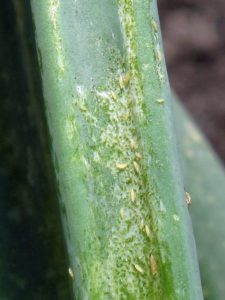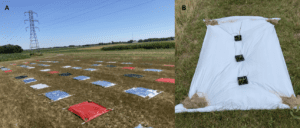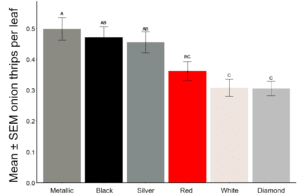Mar 3, 2023Onion thrips management with plastic mulches
Plastic mulches are used in agriculture fields for a variety of reasons, including increased weed control and soil moisture retention when compared to bare soil. However, selecting the correct color of mulch is important.
For example, in cooler climates, a standard black plastic mulch can help raise the soil temperature in the spring, prolonging the growing season and increasing plant growth. In a warmer climate, white plastic mulches will retain soil moisture but will not raise the soil temperature as much as black plastic mulch.
In addition to benefiting plant growth directly, plastic mulches can also be used for insect pest management.

When using plastic mulches for insect pest management, their efficacy is often dependent on the interaction between the color of the mulch and the insect. In tomatoes, red mulches (compared to bare soil), increase the presence of whiteflies while reducing thrips and aphids. Also in tomatoes, black plastic and white plastic mulches increase attractiveness to thrips.
In pepper production, reflective plastic mulches reduce western flower thrips populations by 60%. In zucchini, aphid populations were lowest on reflective mulches. For cucumbers, there were significantly more striped cucumber beetles on black plastic mulches compared to reflective mulches.
Despite the variable outcomes of using plastic mulches for insect management, across most cropping systems, reflective plastic mulches tend to reduce insect populations.
For onion thrips management, reflective silver and red plastic mulches have been reported more effective in reducing their numbers. Interestingly, white plastic mulches and black plastic mulches have been reported to increase thrips populations compared to bare ground. However, none of these mulches have been tested in onion cropping systems, where onion thrips are the main insect pest. This led us to ask two questions:
- Can plastic mulches be used to reduce onion thrips populations?
- Do different types of reflective mulches produce different results?
We set up a field trial at Michigan State University’s Entomology Farm to test the effectiveness of six plastic mulches: black, white and red (made by Ken-Bar), and three reflective mulches:
- The black plastic (1.0 mil) was marketed to increase soil temperatures, retain soil moisture, and suppress weed growth.
- The white mulch (1.25 mil) claimed to reduce soil temperature while increasing the amount of light reflected onto the plant leaves.
- The red mulch (1.0 mil) was designed specifically for tomato production to increase yield.
- The metallic reflective mulch (1.25 mil, Ken-Bar) was marketed to reduce disease spread, which onion thrips are often associated with.
- The silver plastic mulch (thickness not specified, from Dubois Agrinovation) was designed to eliminate weeds and keep plant roots cool.
- The last reflective mulch tested was a “diamond” mulch (6 mil, from Viagrow), which was gray and had a dimpled texture to increase light reflection.

When viewing the reflective mulches, the metallic and silver mulches were nearly identical to the human eye, while the diamond mulch was identifiable by the dimpled texture.
Onion plants were grown in a 50-seedling tray for five weeks inside a growth chamber at 24℃elcius and 16:8 L:D cycle. After five weeks, seedlings were transplanted to individual rectangular pots and returned to the growth chamber for one more week. At six weeks, they were transferred to the field. In the field, each of the six mulches were cut into rectangles (1.2m x 1.8m) and secured by metal stakes. The mulches were arranged in a random block pattern with 15 replicates per color (Photo 1A, above). Three onion pots were placed on top of each mulch sheet (Photo 1B) and plants were scouted for onion thrips weekly for the next six weeks.
After six weeks, we found that some plastic mulches significantly reduced onion thrips populations (chart, below). Compared to the black plastic, the metallic and silver mulches did not reduce onion thrips populations. The red mulch reduced onion thrips populations by almost 30%, compared to the black plastic. White and diamond mulches reduced onion thrips populations by 40% when compared to the black plastic.

Interestingly, we found that there were significant differences between the three reflective mulches. The metallic and silver mulches performed similarly, but the diamond mulch reduced thrips populations significantly compared to the metallic and silver mulches (Figure 2). The vision of onion thrips may be obscured due to the reflected light, decreasing their ability to find an onion plant.
To better understand why the reflective mulches performed differently, we measured the amount of light reflected off the metallic, silver and diamond mulches. We found that the diamond mulch reflected 90% of the light, while the silver and metallic mulches only reflected 60% and 30% of the light, respectively.
The differences in the amount of light reflected may be why the reflective mulches performed differently. These results highlight the need to be selective when using mulches for onion thrips management, and that mulches advertised as reflective may not be equally as effective.
— Natalie Constancio and Zsofia Szendrei, Department of Entomology, Michigan State University
Top photo: MSU entomologists tested six plastic mulches. They were cut into rectangles (A) and secured to the ground. Three potted onions were placed on top of the mulch (B) and were monitored for onion thrips populations weekly for six weeks. Photos: MSU
Chart: Mean +/- SEM onion thrips per leaf in an experiment testing the effects of different colored mulches. Treatments with the same letter indicate no significant differences between the number of thrips.
















